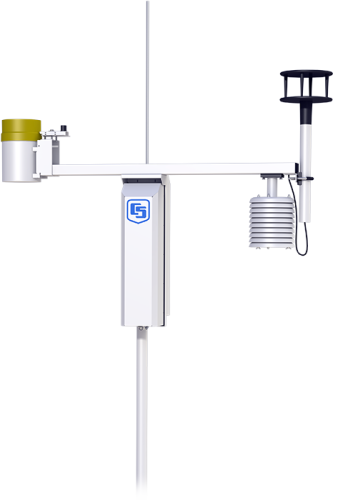
for better irrigation scheduling






Overview
The ET107 is an automated weather station designed for irrigation scheduling in turf grass and commercial agriculture applications. The station calculates potential evapotranspiration (ETo), which is the amount of water lost from the soil due to evaporation and plant transpiration. Calculating evapotranspiration rate can aid in the development of an irrigation schedule that provides sufficient water without overwatering.
Read MoreBenefits and Features
- Monitors temperature, relative humidity, wind speed and direction, solar radiation, and precipitation
- Automatically calculates potential evapotranspiration (ETo)
- Accurate measurements you can rely on
- Pre-configured with some pre-assembly for easy installation
- Rugged, low-power design for long-term, reliable operation
- Looks great and fits well in public settings
- Multiple sensor and communication options
Images





CAD Files:
Detailed Description
Our ET107 ETo station consists of meteorological sensors, an aluminum 3-m pole, and an environmental enclosure that houses a CR1000M module and a 7-Ahr sealed rechargeable battery. The battery is recharged via ac power or a 10-W solar panel. Sealed circular connectors are provided on the outside of the enclosure to simplify sensor hookup.
气象传感器包含ET107the CS305-ET Solar Radiation Sensor, HMP60-ETS Air Temperature and Relative Humidity Probe, TE525-ET Tipping Bucket Rain Gage, and either the 034B-ETM Wind Set or WindSonic1-ETM 2-D Sonic Wind Sensor.
The ET107 can also measure the:
Specifications
| -NOTE- | The ET107 has components that have their own specifications. To review these specifications, refer to the appropriate products below: |
Compatibility
Replacement sensors for the ET107 have a -ET or -ETM suffix. These sensors are listed underOrdering.
The ET107 can also measure the:
Documents
Downloads
ET107 Default Programs (4 KB)03-29-2021
One default program is for an ET107 with the 034B wind sensor and another default program is for an ET107 with a WindSonic1.
ET107 ETsz Example Programs (290 KB)06-23-2021
TheETsz()instruction requires the user to input lattitude, longitude, elevation, and crop type for a station's location in order to generate accurate calculations of ET. The Generic_ET_107_ETsz.CR1 and Generic_ET_107_ETsz_Windsonic.CR1 programs use theConstTable()intruction to create a constants table that allows the user to easily input these values using Loggernet, PC400, or a keyboard display. These values only need to be set once, during station set up.
Frequently Asked Questions
Number of FAQs related toET107:18
Expand AllCollapse All
-
Refer to the “Maintenance, Troubleshooting, and Schematics” section of theET107 Weather Station Instruction Manualfor procedural instructions.
-
Calsense Command Center software can interface with Campbell Scientific’sVisualWeathersoftware, which can retrieve values from the ET107. In the Command Center software, setting up a station involves connecting to theVisualWeather LoggerNetserver and selecting variables from the weather station’s listing for wind speed, rainfall, and ETo.
-
The PS100 power supply that’s in the ET107 specifies a charging voltage of 15 to 28 Vdc or 18 Vac RMS. A 24 Vac transformer will blow the protective circuitry in the PS100.
-
Yes. However, special data logger programming is required. Contact an application engineer at Campbell Scientific for assistance.
-
IfVisualWeatheris used with the ET107, T107 (Toro), ET106, or MetData1, and the station has a standard configuration, setting up the station inVisualWeatheris relatively simple. Select the station from the list in theWeather Station Networkscreen, and most of the work is automatically performed.
If, however, a custom station, a different station model, or a different variation for one of the sensors is used, it is necessary to set up a custom station in theWeather Station Networksetup screens. In theStation Selectionscreen, selectCustom.
Follow the screens that ask about the details of the station. Then,VisualWeather will connect to the station and get the names and fields of the data tables on the station where the data is stored. Because the names and fields of these tables are meaningless toVisualWeather, a mapping process must be used to map data table fields to fields and units thatVisualWeatherrecognizes. This mapping allowsVisualWeatherto create screens and reports that are meaningful.
Because the data tables are often identified with a number and the fields are often cryptic, the mapping process can sometimes be confusing. To map fields for a custom station, contact Campbell Scientific for assistance.
-
Wind speed, wind direction, solar radiation, temperature, relative humidity, and rain measurements are data parameters that are available. Typically, ETo is calculated by the software; however, it is possible for the ET107 to perform the calculation as well.
-
The most significant difference is that the retired ET106 used the CR10X datalogger, whereas the ET107 uses the CR1000 datalogger. Other differences are the following:
- As a design improvement, the ET107 has a seal incorporated into its lid assembly.
- The ET107 uses a CS300 pyranometer instead of the LI200X pyranometer.
- The ET107 provides a choice of wind sensor (either the 034B or the WindSonic1), whereas the ET106 could only be used with the 034B.
-
No.VisualWeathermust be purchased separately.
Case Studies
According to a report from the United States Golf Association (USGA), the average golf course......read more
Articles and Press Releases
Newsletter Articles
Privacy Policy Update
We've updated our privacy policy.Learn More
